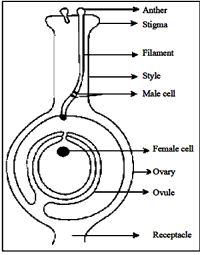NEW! The Gist (APR-24) | E-BOOKS |
(Sample Material) IAS PRE GS Online Coaching : General Science - "Plant Reproduction"
Sample Material of Our Online Coaching Programme
Subject: General Science
Topic: Plant Reproduction
INTRODUCTION
Animal life cycles have meiosis followed immediately by gametogenesis. Gametes are produced directly by meiosis. Male gametes are sperm. Female gametes are eggs or ova. The plant life cycle has mitosis occurring in spores, produced by meiosis, that germinate into the gametophyte hase. Gametophyte size ranges from three cells (in pollen) to several million (in a “lower plant” such as moss). Alternation of generations occurs in plants, where the sporophyte phase is succeeded by the gametophyte phase. The sporophyte phase produces spores by meiosis within a sporangium. The gametophyte phase produces gametes bymitosis within an antheridium (producing sperm) and or archegonia (producing eggs). Within the plant kingdom the dominance of phases varies. Nonvascular plants, the mosses and liverworts, have the gametophyte phase dominant. Vascular plants show a progression of increasing sporophyte dominance from the ferns and “fern allies” to angiosperms.
FLOWERING PLANTS
Flowering plants, the angiosperms, were the last of the seed plant groups to evolve, appearing over 100million years ago during the middle of the Age of Dinosaurs (late Jurassic). All flowering plants produce flowers and if they are sexually reproductive, they produce a diploid zygote and triploid endosperm.

FLOWERS
Flowers are collections of reproductive and sterile tissue arranged in a tight whorled array having very short internodes. Sterile parts of flowers are the sepals and petals. When these are similar in size and shape, they are termed tepals. Reproductive parts of the flower are the stamen (male, collectively termed the androecium) and carpel (often the carpel is referred to as the pistil, the female parts collectively termed the gynoecium).
STAMENS
The individual units of the androecium are the stamens, which consist of a filament which supports the anther. The anther contains four microsporangia within which microspores (pollen) are produced by meiosis. Stamens are thought to represent modified sporophylls (leaves with sporangia on their upper surface.


